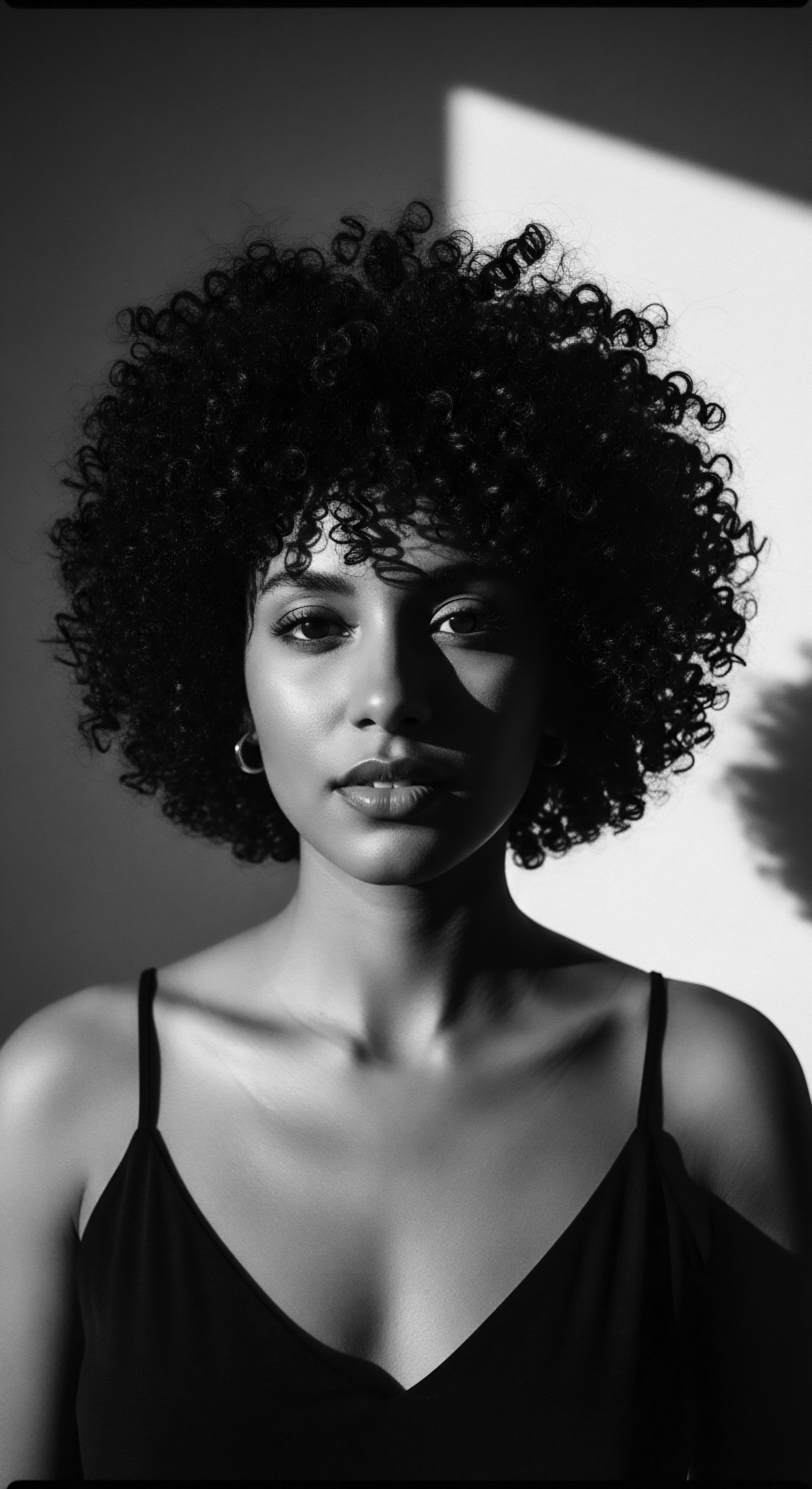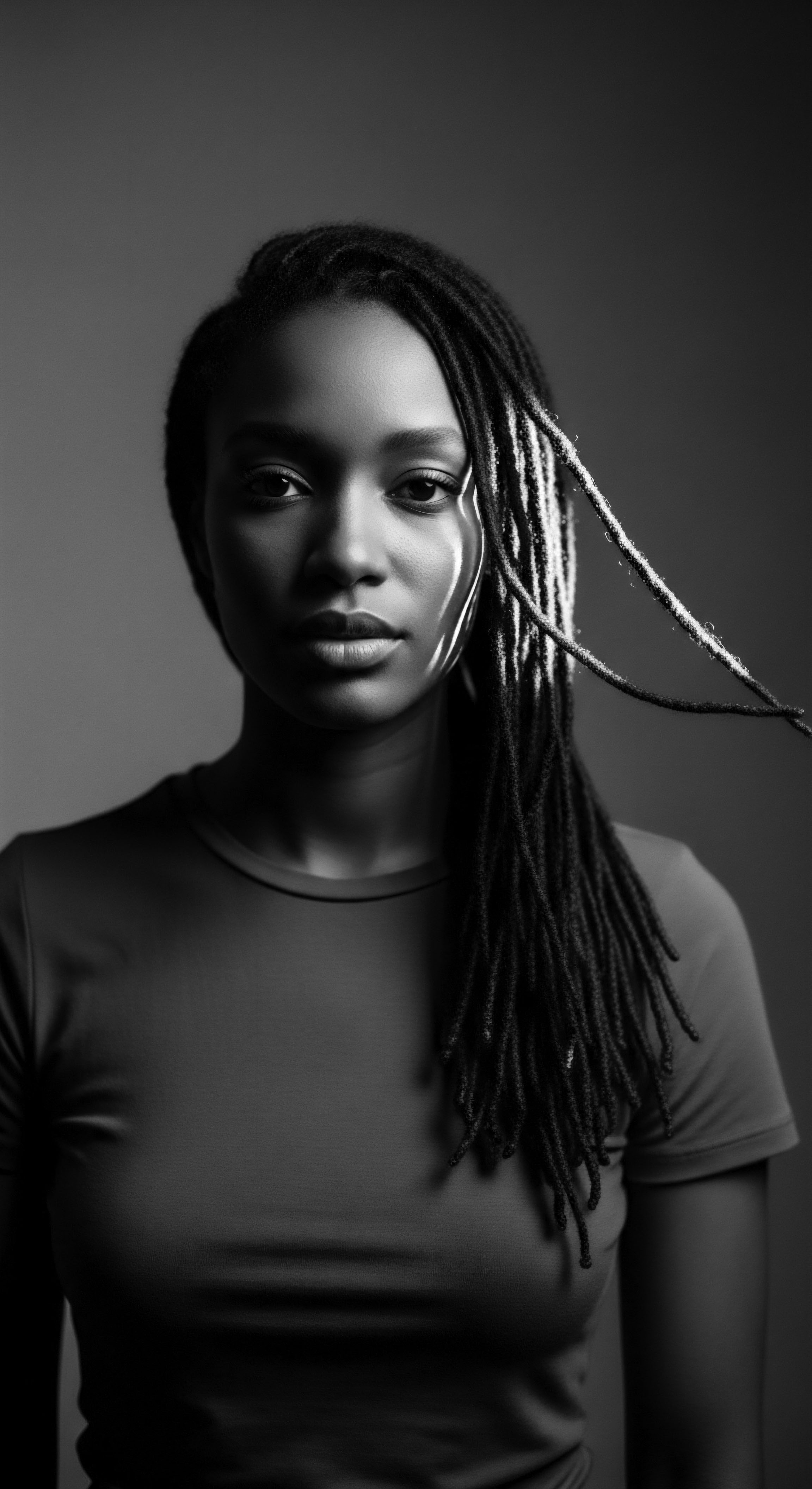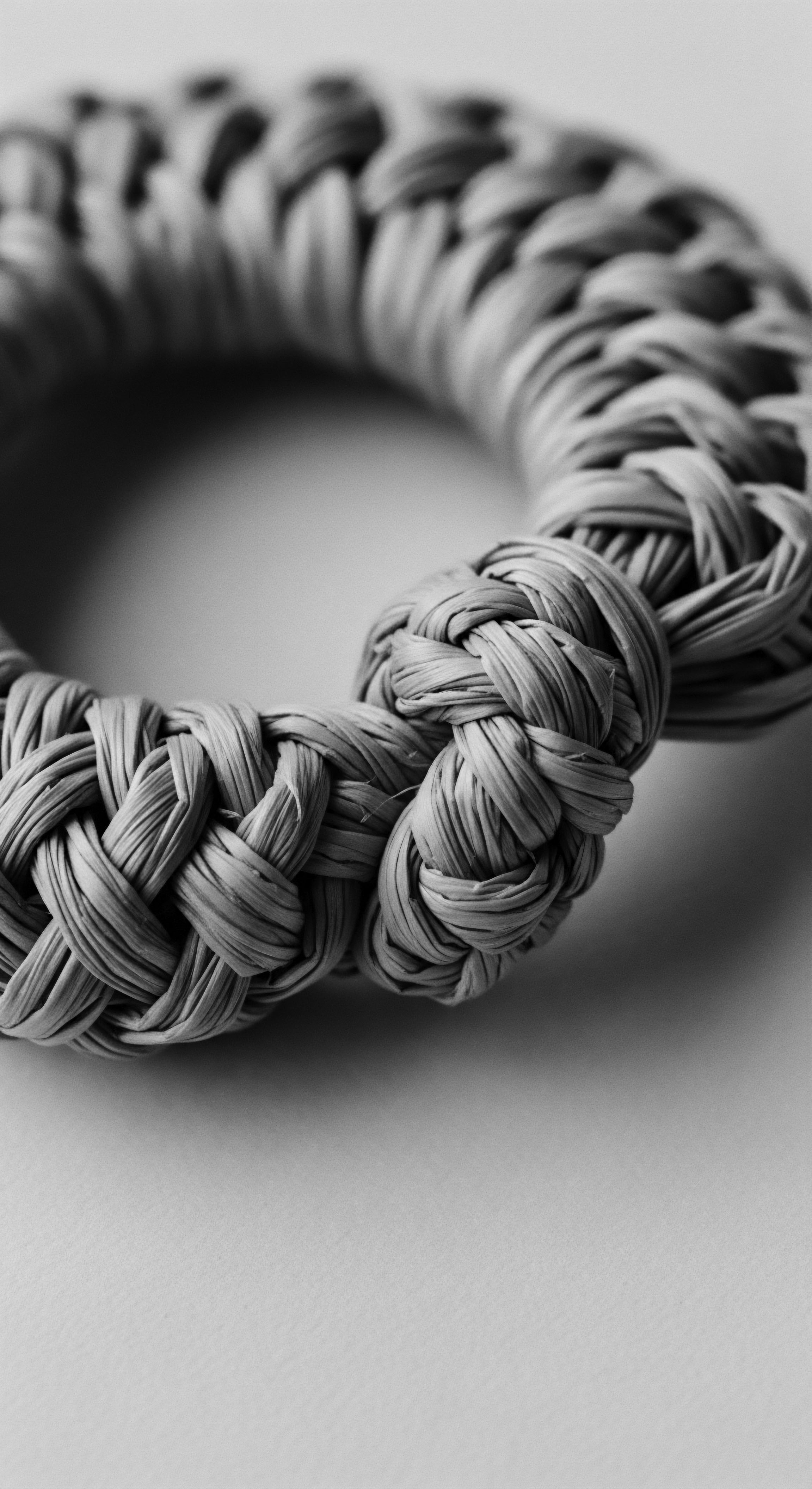
Roots
Consider your textured hair not merely as strands, but as a living archive, a scroll unfurling through generations. Each curl, coil, and wave carries the genetic echoes of ancestors, their wisdom ingrained in its very structure. This heritage extends to the elemental care that protects these magnificent crowns from the world’s harshness. Fatty acids, the unsung guardians often found in the heart of traditional botanical oils and butters, hold a significant place in this ancestral protective legacy.
Their role reaches back to the earliest moments of human self-adornment and care, long before the language of molecular science offered its explanations. They form a biological shield, a subtle yet mighty defense against breakage and dehydration, especially for hair types that are inherently more prone to moisture loss and external stressors.

Ancestral Lipid Legacy
Long before laboratories isolated compounds, our forebears understood, through observation and inherited wisdom, the nourishing properties of certain plants and their yielded oils. Across African lands and throughout the diaspora, ingredients rich in what we now understand as fatty acids were central to hair care. These were not simply cosmetic applications; they were rituals of preservation, acts of communal bonding, and expressions of identity. The richness of ingredients like Shea Butter from West Africa, Coconut Oil prominent in both Indian and Pacific Islander traditions, and Castor Oil widely used in Caribbean and African practices, speak to a deep, shared understanding of what keeps textured hair resilient.
These natural substances, passed down through oral traditions and hands-on teaching, provided a protective layer, sealing moisture and adding a soft sheen. They were intuitive answers to the hair’s inherent needs.

Hair’s Intrinsic Design and Lipid Connection
The structure of textured hair, with its unique bends and twists, naturally presents more points of vulnerability along the hair shaft compared to straighter hair types. These structural differences mean that natural oils produced by the scalp, known as sebum, struggle to travel uniformly down the entire length of the strand. This often leaves the ends, and even mid-lengths, more exposed and prone to dryness. This is where external lipids, particularly the fatty acids present in plant-derived oils, become profoundly relevant.
They supplement the hair’s natural defenses, forming a protective film around the cuticle, which is the outermost layer of the hair. This film helps to seal the cuticle scales, minimizing water loss and maintaining the delicate moisture balance that textured hair craves. Without sufficient lipids, hair can become brittle, leading to split ends and breakage.
Fatty acids act as silent protectors, echoing ancestral wisdom in the very biology of hair resilience.

Early Care Customs
The earliest hair care customs across communities with textured hair were often rooted in local flora and the practical application of their bounties. The preparation of these oils and butters was itself a cultural act, often performed communally, passing down knowledge from elders to younger generations. The women who meticulously processed shea nuts or pressed coconut flesh understood, without modern scientific terms, the inherent goodness that these fats brought to their hair.
This ancestral care was not an isolated act but a part of a larger wellness philosophy, where the body, spirit, and community were intertwined. The oils were not just for hair; they often served as remedies for skin, balms for aches, and even culinary staples, underscoring their integral role in daily life.

Ritual
The tender acts of hair care in textured hair traditions are more than mere routine; they are sacred rituals, steeped in generational knowledge and a profound respect for the crown. Within these rituals, the application of fatty acid-rich oils has held a central position, acting as a bridge between the physical act of care and the spiritual connection to heritage. These practices, honed over centuries, demonstrate an innate understanding of how to maintain the hair’s integrity and vibrancy, ensuring its protection from the elements and the wear of daily life. The wisdom embedded in these methods speaks volumes about the protective power of specific fatty acids.

The Sacred Act of Oiling
Across diverse communities, oiling the hair has been a cornerstone of care. From the ceremonial anointing of hair in ancient Egypt with Castor Oil to the widespread practice of regular oil massages in India using Coconut Oil, this ritual signifies nourishment and protection. For textured hair, this practice holds particular importance due to its structural characteristics, which make it more susceptible to dryness. The very act of applying these oils, gently working them through strands or massaging them into the scalp, was an intimate form of communion with one’s hair.
This simple, yet powerful, ritual provides a vital layer of lubrication, reducing friction and minimizing the damage that can occur during styling and manipulation. The fatty acids within these oils coat the hair shaft, reinforcing its external lipid layer and contributing to improved elasticity.

Crafting Elixirs from the Earth
Traditional elixirs were often concocted from ingredients readily available in the local environment, each chosen for its specific properties. The preparation of these mixtures was frequently a communal activity, allowing for the sharing of techniques and the reinforcing of cultural bonds.
- Shea Butter ❉ Sourced from the shea tree in West and Central Africa, this butter is rich in fatty acids, particularly oleic and stearic acids. It has been used for centuries to deeply moisturize, provide a protective barrier against environmental stressors, and reduce the appearance of dryness.
- Palm Kernel Oil ❉ Also originating from West Africa, this oil contributes significantly to hair strength and reduced breakage, often found in traditional formulations for textured hair due to its nourishing properties.
- Castor Oil ❉ Known for its thick consistency and high content of ricinoleic acid, castor oil was, and still is, a staple across African, Caribbean, and Latin American hair care. Its use is associated with strengthening hair, promoting scalp health, and enhancing thickness.
- Coconut Oil ❉ A global favorite, deeply rooted in Indian and Southeast Asian traditions, its lauric acid content allows it to penetrate the hair shaft, reducing protein loss and providing deep conditioning.

Protective Styling and Lipid Support
The art of Protective Styling, such as braids, twists, and bantu knots, has been a central practice in textured hair communities for generations. These styles shield the hair from daily manipulation and environmental exposure, but their effectiveness is amplified when paired with the deep nourishment offered by fatty acid-rich oils. Before styling, oils are often applied to lubricate the strands, making them more pliable and less prone to breakage during the braiding or twisting process.
This combined approach of structural protection and internal reinforcement from lipids has been vital for retaining length and maintaining the health of textured hair over time. The careful coating of strands before braiding, a practice seen in many ancestral communities, inherently understood the need to seal in moisture and provide a smooth surface to minimize abrasion.
Traditional oiling and protective styles form a synergistic dance, preserving the hair’s strength and lineage.

Relay
The continuation of ancestral wisdom into our present understanding of hair care is a testament to the enduring power of observation and inherited knowledge. What our forebears intuitively understood, modern science now articulates with molecular precision. Fatty acids, those deceptively simple molecules, serve as the unsung champions in the protection of textured hair, forming a fundamental link between age-old customs and contemporary scientific insight. Their ability to interact with the hair at a cellular level provides a robust defense against common forms of damage.

Molecular Guardians of the Strand
The outer layer of the hair, the cuticle, acts as a protective shield for the inner cortex. A healthy cuticle, characterized by overlapping scales, is hydrophobic, meaning it repels water, which is essential for maintaining moisture balance and structural integrity. This hydrophobicity is largely maintained by the lipid layer on the hair’s surface, a delicate barrier composed of fatty acids, ceramides, and cholesterol. When this lipid layer is compromised by styling, environmental factors, or even harsh cleansing, the hair becomes vulnerable to moisture loss and protein degradation.
Fatty acids, particularly those with smaller molecular weights and straight chain structures, can penetrate the hair shaft, reaching beyond the cuticle to the cortex. This internal lubrication and reinforcement are crucial for textured hair, which often experiences natural gaps in its cuticle layer due to its unique curl pattern, making it inherently more susceptible to damage.

Fatty Acid Profiles in Traditional Oils
Different plant oils, revered in heritage practices, offer distinct fatty acid compositions, each contributing unique protective qualities.
| Fatty Acid Lauric Acid |
| Primary Source Oils Coconut Oil, Palm Kernel Oil, Murumuru Butter |
| Protective Mechanism for Hair Penetrates deeply due to small size, reducing protein loss and fortifying internal structure. |
| Fatty Acid Oleic Acid |
| Primary Source Oils Shea Butter, Olive Oil, Avocado Oil |
| Protective Mechanism for Hair Forms a surface barrier, providing intense moisture, conditioning, and enhancing flexibility. |
| Fatty Acid Ricinoleic Acid |
| Primary Source Oils Castor Oil |
| Protective Mechanism for Hair Offers moisturizing, anti-inflammatory, and antimicrobial benefits for scalp health, indirectly supporting hair strength and growth. |
| Fatty Acid Stearic Acid |
| Primary Source Oils Shea Butter, Cocoa Butter |
| Protective Mechanism for Hair Provides a rich, emollient layer, sealing moisture and adding a protective coating to the hair surface. |
| Fatty Acid These varied fatty acid profiles explain the diverse benefits observed in traditional hair care ingredients across communities. |
Lauric Acid, found abundantly in coconut oil, serves as a prime example of scientific validation of traditional practice. This medium-chain fatty acid possesses a unique molecular structure, allowing it to easily penetrate the hair shaft. A seminal study by Rele and Mohile (2003) demonstrated that coconut oil significantly reduced protein loss for both undamaged and damaged hair when used as a pre-wash or post-wash product.
This discovery provided a scientific basis for the long-held belief in the protective power of coconut oil in various ancestral hair care traditions, from Ayurvedic rituals in India to practices in the African diaspora. The oil’s ability to bind with hair proteins effectively forms a barrier, minimizing the structural degradation that leads to breakage and split ends, a common concern for textured hair.

The Science Behind Ancestral Protection
The protective role of fatty acids extends beyond simple conditioning. They aid in maintaining the hair’s intrinsic lipid content, which is crucial for its mechanical properties, such as elasticity and resistance to breakage. When the hair’s natural lipids are depleted, it becomes more susceptible to environmental stressors like UV radiation, pollution, and the mechanical stress of styling.
Oleic Acid and Stearic Acid, major components of shea butter and olive oil, contribute to the hair’s external defense. These longer-chain fatty acids remain more on the surface, creating a lubricious coating that reduces friction between hair strands and from external forces. This surface protection helps to smooth the cuticle, leading to reduced frizz and enhanced shine, qualities that have always been valued in the aesthetic of well-cared-for textured hair.
Scientific inquiry confirms what ancestors knew instinctively ❉ certain fatty acids are fundamental to hair health and damage defense.

Future Strands, Ancient Wisdom
Understanding the specific contributions of these fatty acids allows for a more informed approach to textured hair care today. It provides a scientific lens through which to appreciate the enduring wisdom of ancestral practices. The effectiveness of traditional oils and butters in safeguarding textured hair from damage is not anecdotal; it is deeply rooted in their biochemical composition and how these compounds interact with the hair’s unique structure. The journey of these fatty acids, from the heart of a plant to the crown of textured hair, represents a continuous flow of knowledge and a deep connection to our collective heritage.

Reflection
The conversation surrounding fatty acids and their role in protecting textured hair reaches beyond chemical compositions and molecular interactions. It is a profound meditation on the enduring legacy of care, a testament to the wisdom that flowed through generations, shaping rituals and self-expression. The ‘Soul of a Strand’ ethos reminds us that each coil and curve carries not just biological information, but stories—of resilience, ingenuity, and a deep, abiding connection to the earth’s offerings. To truly understand which fatty acids protect textured hair from damage is to walk a path illuminated by ancestral practices, recognizing that the very oils our forebears extracted from botanicals were imbued with the very compounds modern science now isolates and studies.
This understanding fosters a reverence for the past, allowing us to build a future of care that honors our heritage, strengthens our strands, and celebrates the unique beauty inherent in every texture. Our textured hair, always growing, always transforming, remains a living, breathing archive of this continuous journey.

References
- Rele, Aarti S. and Mohile, R. B. (2003). Effect of mineral oil, sunflower oil, and coconut oil on prevention of hair damage. Journal of Cosmetic Science, 54(2), 175-192.
- Deoleo. (2022, April 22). Olive oil for the hair ❉ likely benefits – and some cautions.
- Spreading Clean Beauty. (n.d.). Lipid layer ❉ what it is, its function and how to take care of it.
- Brillare. (2021, October 27). Lipids are the unsung heroes of the hair.
- Faith In Nature. (n.d.). Coconut Oil For Hair.
- Livara Natural Organics. (2023, February 7). Black History Month ❉ The Rich History of Our African Hair.
- The London PRP Clinic. (2024, June 27). Is Coconut Oil good for your hair?
- Ciafe. (2023, January 31). Shea Butter – Explainer.
- ResearchGate. (n.d.). Effect of mineral oil, sunflower oil, and coconut oil on prevention of hair damage.
- Chemiis. (n.d.). Oleic Acid ❉ Uses, Benefits, Applications, and Safety Guidelines.
- My Trichologist. (2025, April 21). The Incredible Benefits of Organic Coconut Oil for Your Scalp and Hair.
- LABORIE derma. (n.d.). What are lipids and why structure hair needs them?
- NaturallyCurly – Beautycon.com. (2014, December 2). Oleic & Linoleic Acid ❉ The Reason You Love Oils So Much.
- Orifera. (2024, October 13). The History of Coconut Oil and Its Cultural Significance Across the World.
- BRAZIL-PROF. (n.d.). Lipids in hair cosmetics ❉ role, benefits and selection features.
- NeoCurly. (2024, March 20). Utilizing Coconut Oil Benefits for Textured Hair.
- Battle Born Grooming Co. (n.d.). Castor Oil ❉ Hair & Scalp Health’s Natural Ally.
- Health. (2025, April 26). Should You Use Castor Oil for Hair Growth? 5 Benefits.
- KhalidaNaturals. (n.d.). Natural Hair Care for Kinky, Coily Textures.
- Joanna Colomas. (2023, December 2). Unlock Ancient Hair Care Secrets ❉ Discover Global Rituals for Lustrous Locks.
- Africa Imports. (n.d.). Traditional African Secrets For Long And Healthy Hair.
